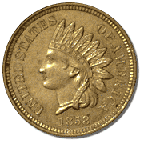
11.
The bison on the Buffalo Nickel once roamed New York City...
Named Black Diamond, this bison roamed "The Big Apple" around the turn of the century. And as far as we know, Black Diamond never roamed outside of the Bronx Zoo—his New York City home.
12.
One Commemorative Coin bears 5 dates...but not the date it was struck!
The 1937 half-dollar struck to honor Norfolk, Virginia's founding, becoming a town, then a borough, has 1636, 1682, 1736, 1845, and 1936, but not 1937, the date the coin was made.
13.
There were copper pennies and white cents?
Yes, there were "white cents" that didn't look at all like pennies. These were the Flying Eagle one cent coins of 1856–58 and the Indian Head one cent coins of 1859–64. They were made from metal that contained 88 parts copper to 12 parts nickel, which gave them a light or white color.
14.
When it's time for change?
The Secretary of the Treasury may change circulating coinage designs after 25 years. Congress, however, can authorize a change prior to 25 years.
15.
This Native American had three different faces.
According to artist James E. Fraser, the Native American on the Indian Head and Buffalo nickels was actually a combined image created from three people: a Cheyenne Named Chief Two Moons, an Iroquois named Chief John Big Tree, and a Sioux named Chief Iron Tail.
16.
Her best soup spoons make good pocket change.
Legend has it that Martha Washington donated the silverware from her table to make the nation's first currency.
17.
Half a dime wasn't a nickel then.
The first American coins were half dimes—spelled "dismes"—which were struck in the fall of 1792. Though worth 5 cents, they contained no nickel, but were mostly silver with a trace of copper. The first circulating coins were one cent pieces made the following year.
18.
Before the Mint Police, there was a Mint Pup.
Old records show that $3 was spent to purchase a watchdog to protect the first Mint in Philadelphia.

19.
How old is Peter, the original Mint Eagle?
On display at the Philadelphia Mint is Peter, the bald eagle who lived at the first Mint and was befriended by its employees. After his untimely death, the workers had Peter mounted, and he has remained on display for more than 150 years.
20.
The first Mint had a lot of horse power.
Horses, oxen, and men powered the Mint's coin presses before 1816. The first steam operated coin press appeared in 1836.




